Home

This is the VHS-Decode Wiki written and maintained by Harry Munday (harry@opcomedia.com), Inside this wiki and its pages, you will find everything! from easy-to-understand technical guidance and notations for getting a signal out of VCRs, capturing original FM RF signals off of tapes, storing them and finally processing them into lossless digital media archives.
VHS-Decode is part of a family of software sharing the same tools.
CVBS (Composite) Decode / HiFi Decode / RTLSDR HiFi Decode / LaserDisc Decode / CD-Decode / FL2K TBC Player
Don't know half the words used or things are?
Acronyms-Guide alongside the The Frequently Asked Questions page will help.
We have a overview YouTube video!
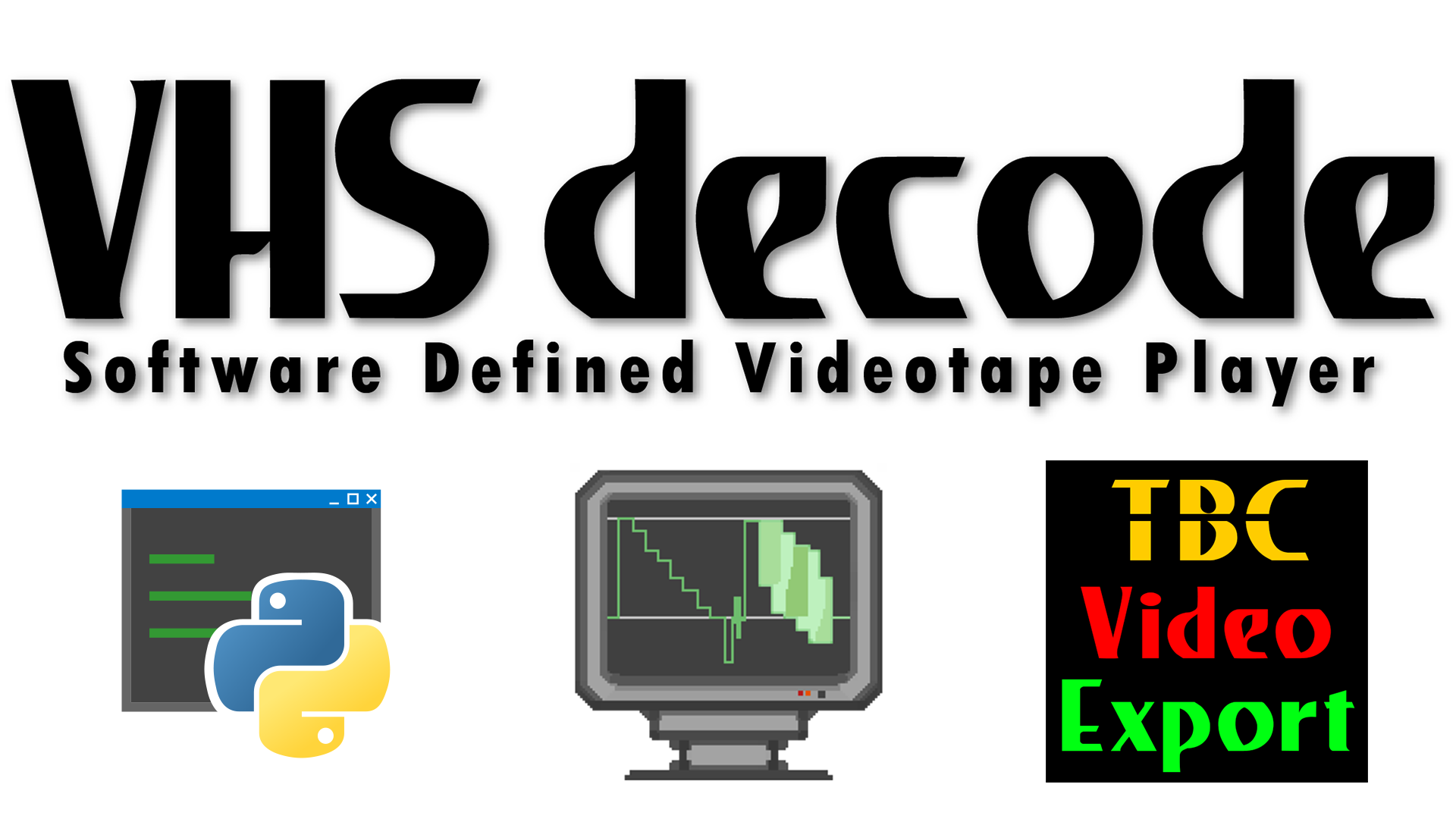
Odysee Offical VHS-Decode - TheRealHarrypm
Odysee The Rewinding - MrCarter
YouTube The Video Dump Channel - Jitterbug
Bypass all non-essential hardware, and process it all in software directly.
Capture today decode tomorrow!
Practically Any VCR/VTR --> FM RF Capture --> Universal RF File of Video/HiFi Signals
RF File of Tape --> FLAC Compression --> Optical Archive or LTO Tape Archive.
RF File --> VHS-Decode --> Software Demodulation & Timebase Correction --> Composite/S-Video .TBC Files --> Chroma-Decoder -> Interlaced Video Files -> Deinterlacing -> Use on modern devices.
RF File --> HiFi Decode --> Software Demodulation --> Noise Filtering --> Lossless 192khz 24-bit FLAC Audio --> Mux to video files.
Thanks to low-cost analogue to digital converters CX Cards & RTLSDR alongside the DomesDayDuplicator direct digitisation and archival of many magnetic analouge media formats can be done not only properly but affordably with original FM RF (Frequency Modualted Radio Frequency) signals being captured and preserved in the digital file realm.
Unlike baked-in standard S-Video/Composite and line-out HiFi audio capture, FM RF capture offers the full original tape signals making a true digital master copy of your analogue media removing the need for expensive time base correctors and even working physical players in the future.
RF capture and subsequent software decoding provides anyone with a standard desktop or laptop a complete software-defined videotape player with a full suite of "after the fact" broadcast level processing & manipulation tools with a full-frame software-based time base corrector, drop out detection, and compensation.
With basic use being a fluid copy-paste drag and drop experience supporting multiple tape formats not just VHS and an extensive list of decoding options allowing for endless adjusting potential if required.
Unlike conventional methods software decoding provides not only the visual picture area but the entire signal frame including the vertical blanking area (VBI) so information such as Closed Captions, VITC Timecode and Teletext can be visually inspected and digitally decoded automatically via ld-process-vbi to a standard .JSON metadata file or via 3rd party tools like VHS-Teletext.
| TV System | Full-Frame 4fsc | Frequency | Frame Rate | Field Rate | Data Rate CVBS | Data Rate Y+C |
|---|---|---|---|---|---|---|
| PAL | 1135x624 | 17727262 Hz | 25i | 50i | 280mbps 2.1GB/min | 560mbps 4.2GB/min |
| NTSC | 910x524 | 14318181 Hz | 29.97i | 59.94i | 226.5mbps 1.7GB/min | 453mbps 3.4GB/min |
Thanks to the Time Base Corrected Format (Wikipedia Write-Up)
The format is a fully open standard method of containing the full contents of a composite or Y/C separated video signal, this is similar to the 4fsc D2/D3 lossless SD broadcast tape formats but in a binary digital file format ready for software chroma decoding or playback via DACs.
The data is stored in the 16-bit GREY16 format and Luminance (Y) files can be used with FFmpeg directly to render a greyscale full frame "open-matte" video, however the Chrominance (C) is QAM modulated hence "Digital S-Video" being a apt term.
Also providing flexible export options for the image frame area.
LD-Analyse (TBC Inspection Tool)
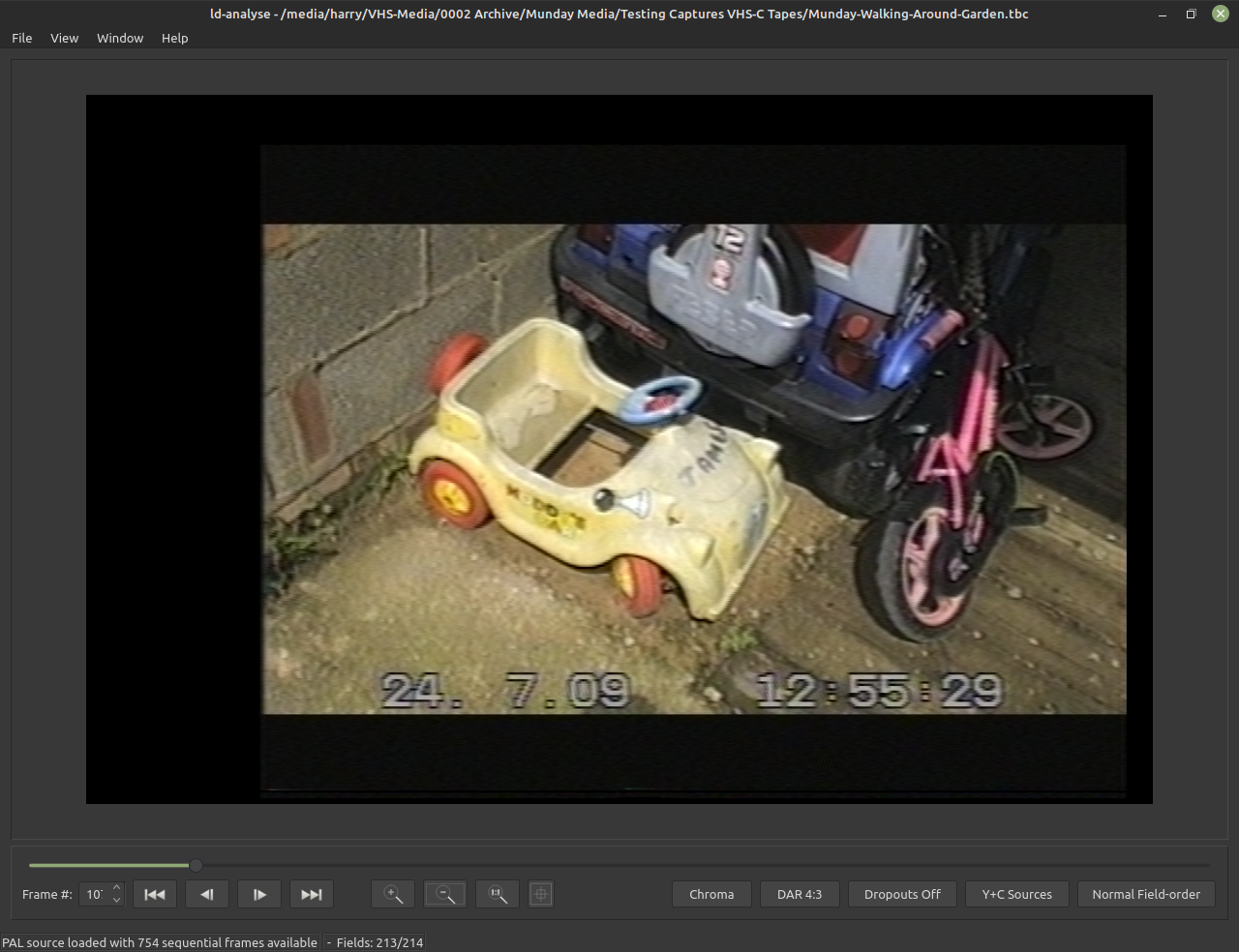
To see more expanded examples see the The Visual Diagrams Page.
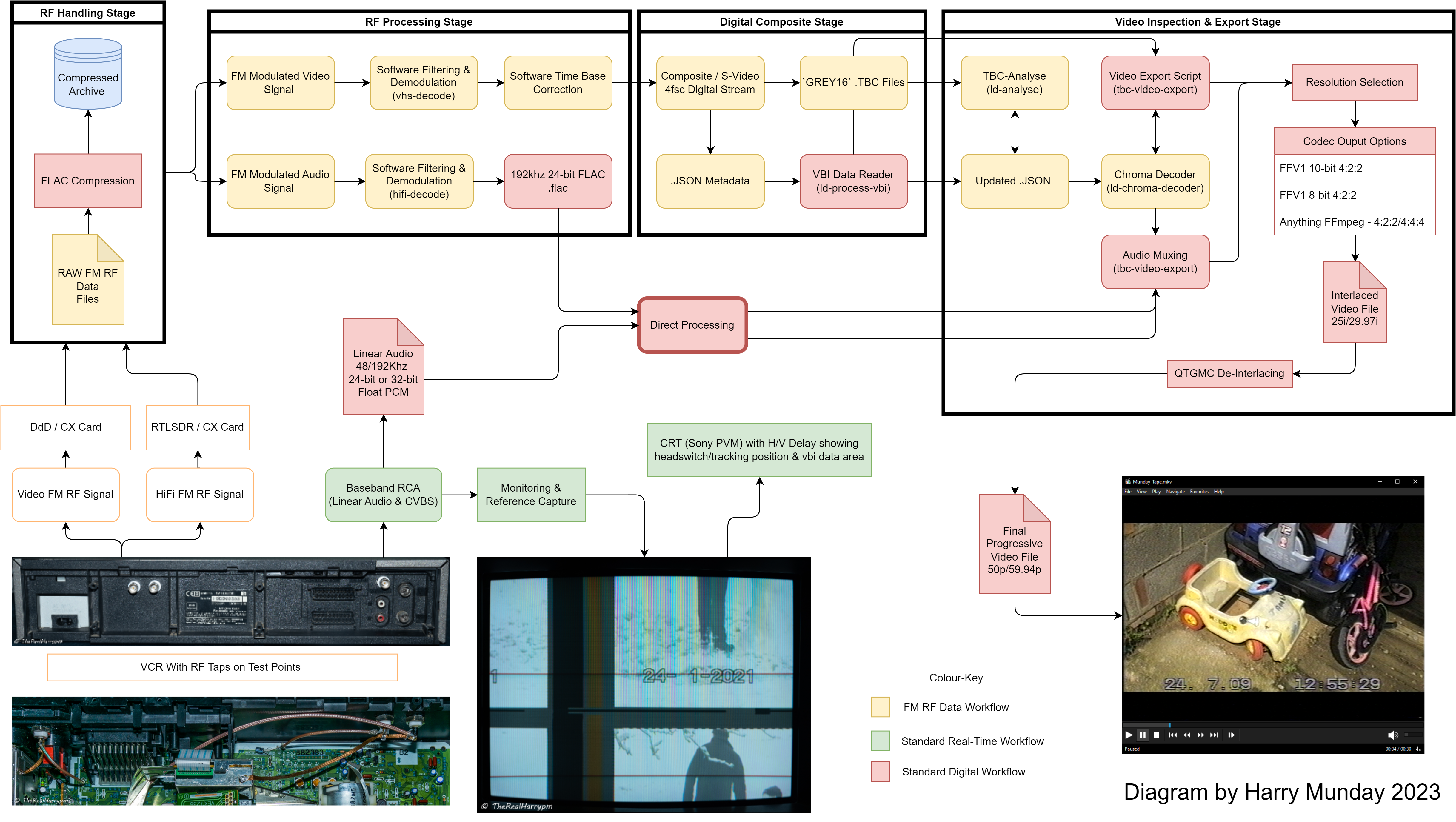
After FM RF capture analogue media can then be decoded to the Time Base Corrected format this uses 4fsc sampling in non-square pixels, this provides the full signal area, covering all possible information in the visible and non-visible areas, it also allows backwards support for playback to analogue systems as media see Analogue Playback for more information.
Unlike conventional capture, Closed Captions, Teletext, VITC timecode, VITS test signals and more can all be recovered and even re-created digitally.
These TBC files can be played and inspected with ld-analyse (GNU radio too!), and easily 1 command encoded into standard colour or black & white video files in codec formats such as FFV1 for further use or direct archival.
This applies to both Video & HiFi FM RF
VCR/VTR Player --> FM Test Points --> Capacitor (0.1uf to 10uf) --> Cabling 50Ohm RG316/RG178 --> BNC or SMA Bulkhead --> "RF Tap" point mounted or snaked out the back of the device.
RF Tap --> RF Capture Hardware (CX Card or DdD) -> 8-bit or 16-bit RF Samples --> RF Data File --> Software Chain.
Note Sony's Video8 & Hi8 is only 1 RF signal point that contains Video/FM HiFI/RCTC-Timecode
FM RF Data File -> FLAC Compression (this can be at the original capture rate or down-sampled)
For installation read the installation guides under the wiki tab.
Video FM File (RAW or FLAC) -> VHS-Decode -> Demodulation & Time Base Correction -> video.tbc & video_chroma.tbc -> VBI Data Extraction ld-process-vbi -> ld-analyse Inspection & adjustment -> Video Export Video stream generation -> RGB/YUV Uncompressed Stream -> tbc-video-export FFmpeg Encode -> Final Interlaced Video File.
HiFi FM File (RAW or FLAC) -> HiFi Decode -> Demodulation & Noise Reduction -> FLAC 24-bit 192khz audio file (.flac / .wav)
Standard 760x488 NTSC & 928x576 PAL
|
Standard + VBI 760x528 NTSC & 928x616 PAL
|
|---|---|
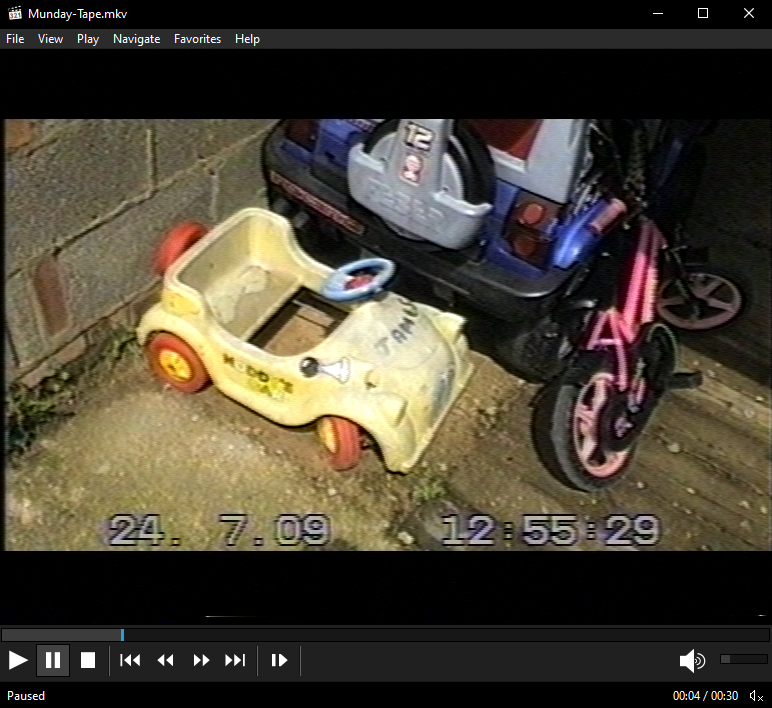 |
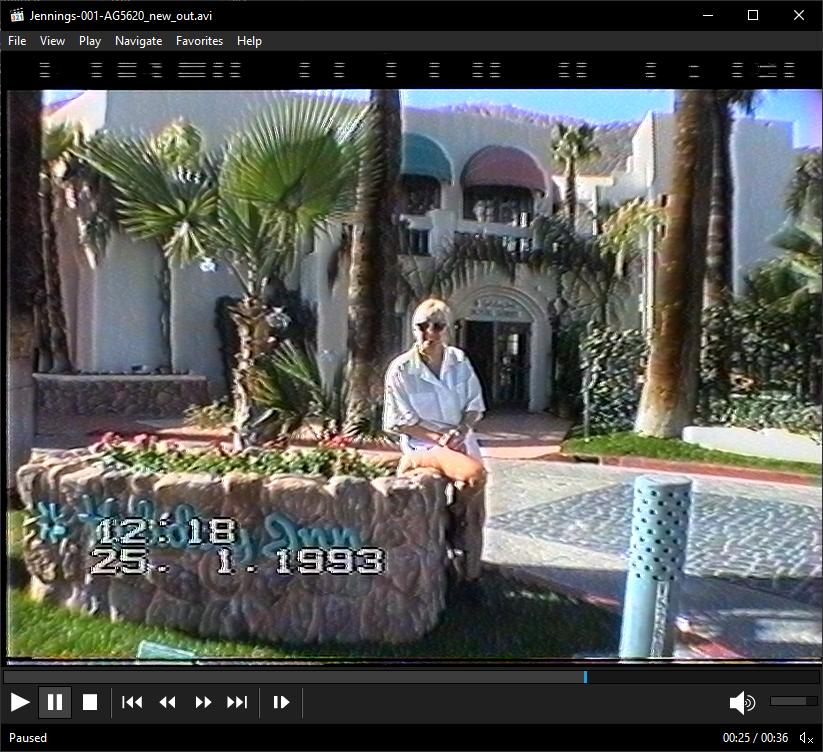 |
For viewing media we recommend players such as Media Player Classic or VLC.
The decoded lossless TBC output is then run through the chroma-decoder (comb-filter in NTSC speak) which recovers the original colour and can output it as a RGB or YUV stream.
Using this stream you can create a interlaced video file from your Composite or Y/C separated TBC files, and you have a few options for frame size which can be adjusted based on your media type such as media with VBI data, or letterbox cropped media.
tbc-video-export is the cross platform tool used to create a final starting video file via the Chroma-Decoder & FFmpeg.
The default output is lossless compressed archival ready FFV1 & FLAC video and audio streams in the reliable .mkv (Matroska) container, but many FFmpeg Profiles are available from ProRes HQ to 8mbps De-Interlaced Odysee ready files and its easy to add your own via the tbc-video-export.json file at any time.
-
Lossless Cut & DaVinci Resolve are recommended For editing.
After the interlaced video files are created they can then be de-interlaced quickly with bwdif but today with deinterlacers like QTGMC can be easily used inside of StaxRip with a few clicks providing a very high-quality motion accurate progressive video files.
VHS-Decode supports decoding both stable and especially unstable media incredibly well with added support for SMPTE-C/Umatic SP/EIAJ/Philips VCR - 2023
VHS-Decode has support added for Video8, Hi8 - 2022
VHS-Decode beats out Panasonics & JVC's prosumer and professional internal TBC cards such as the ones found inside the NV-HS950B, AG-1980P, AG-7650, and well-known external TBCs like the Data Video TBC-1000/TBC-3000 and the FORA FA-310P - 2021
- Cross Platform Support
- Software Time Base Correction
- Full Post Signal Decoding Control
- Advanced dropout detection and concealment
- Advanced VBI Data Reader (Metadata Extraction)
- Backwards Support to analogue systems.
- Wide scope of tape formats supported.
- Easy profile based video file exporting.
Your VCR needs to be mechanically stable and able to track the tape this means decks that are dramatically out of spec will have to be adjusted that's about it, standard capture rules of thumb such as tracking adjustment per tape/segment with channel up/down buttons/sliders or knobs on pro decks and keeping the heads/guides clean still applies.
In the future, It would be ideal to capture all head drum signals with a custom amp/capture board and then do tracking in software, but for now, refining an already tried and working test point path based capture and increasing format support is the clear priority alongside increasing the processing speed, and building on standardised workflows.
- FAQ - Frequently Asked Questions
- Diagram Breakdowns
- Visual-Comparisons
- VCR Reports / RF Tap Examples
- Download & Contribute Data
- Speed Testing
- Visual VBI Data Guide
- Closed Captioning
- Teletext
- WSS Wide - Screen Signalling
- VITC Timecode
- VITS Signals
- XDS Data (PBS)
- Video ID IEC 61880
- Vapoursynth TBC Median Stacking Guide
- Ruxpin-Decode & TV Teddy Tapes
- Tony's GNU Radio For Dummies Guide
- Tony's GNU Radio Scripts
- DomesDay Duplicator Utilities
- ld-decode Utilities